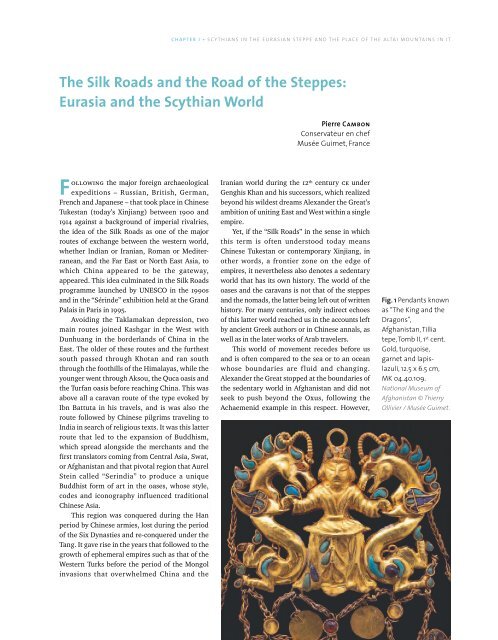Scythian Culture - Preservation of The Frozen Tombs of The Altai Mountains (UNESCO)
Create successful ePaper yourself
Turn your PDF publications into a flip-book with our unique Google optimized e-Paper software.
CHAPTER I • SCYTHIANS IN THE EURASIAN STEPPE AND THE PLACE OF THE ALTAI MOUNTAINS IN IT<br />
<strong>The</strong> Silk Roads and the Road <strong>of</strong> the Steppes:<br />
Eurasia and the <strong>Scythian</strong> World<br />
Pierre Cambon<br />
Conservateur en chef<br />
Musée Guimet, France<br />
Following the major foreign archaeological<br />
expeditions – Russian, British, German,<br />
French and Japanese – that took place in Chinese<br />
Tukestan (today’s Xinjiang) between 1900 and<br />
1914 against a background <strong>of</strong> imperial rivalries,<br />
the idea <strong>of</strong> the Silk Roads as one <strong>of</strong> the major<br />
routes <strong>of</strong> exchange between the western world,<br />
whether Indian or Iranian, Roman or Mediterranean,<br />
and the Far East or North East Asia, to<br />
which China appeared to be the gateway,<br />
appeared. This idea culminated in the Silk Roads<br />
programme launched by <strong>UNESCO</strong> in the 1990s<br />
and in the “Sérinde” exhibition held at the Grand<br />
Palais in Paris in 1995.<br />
Avoiding the Taklamakan depression, two<br />
main routes joined Kashgar in the West with<br />
Dunhuang in the borderlands <strong>of</strong> China in the<br />
East. <strong>The</strong> older <strong>of</strong> these routes and the furthest<br />
south passed through Khotan and ran south<br />
through the foothills <strong>of</strong> the Himalayas, while the<br />
younger went through Aksou, the Quca oasis and<br />
the Turfan oasis before reaching China. This was<br />
above all a caravan route <strong>of</strong> the type evoked by<br />
Ibn Battuta in his travels, and is was also the<br />
route followed by Chinese pilgrims traveling to<br />
India in search <strong>of</strong> religious texts. It was this latter<br />
route that led to the expansion <strong>of</strong> Buddhism,<br />
which spread alongside the merchants and the<br />
first translators coming from Central Asia, Swat,<br />
or Afghanistan and that pivotal region that Aurel<br />
Stein called “Serindia” to produce a unique<br />
Buddhist form <strong>of</strong> art in the oases, whose style,<br />
codes and iconography influenced traditional<br />
Chinese Asia.<br />
This region was conquered during the Han<br />
period by Chinese armies, lost during the period<br />
<strong>of</strong> the Six Dynasties and re-conquered under the<br />
Tang. It gave rise in the years that followed to the<br />
growth <strong>of</strong> ephemeral empires such as that <strong>of</strong> the<br />
Western Turks before the period <strong>of</strong> the Mongol<br />
invasions that overwhelmed China and the<br />
Iranian world during the 12 th century ce under<br />
Genghis Khan and his successors, which realized<br />
beyond his wildest dreams Alexander the Great’s<br />
ambition <strong>of</strong> uniting East and West within a single<br />
empire.<br />
Yet, if the “Silk Roads” in the sense in which<br />
this term is <strong>of</strong>ten understood today means<br />
Chinese Tukestan or contemporary Xinjiang, in<br />
other words, a frontier zone on the edge <strong>of</strong><br />
empires, it nevertheless also denotes a sedentary<br />
world that has its own history. <strong>The</strong> world <strong>of</strong> the<br />
oases and the caravans is not that <strong>of</strong> the steppes<br />
and the nomads, the latter being left out <strong>of</strong> written<br />
history. For many centuries, only indirect echoes<br />
<strong>of</strong> this latter world reached us in the accounts left<br />
by ancient Greek authors or in Chinese annals, as<br />
well as in the later works <strong>of</strong> Arab travelers.<br />
This world <strong>of</strong> movement recedes before us<br />
and is <strong>of</strong>ten compared to the sea or to an ocean<br />
whose boundaries are fluid and changing.<br />
Alexander the Great stopped at the boundaries <strong>of</strong><br />
the sedentary world in Afghanistan and did not<br />
seek to push beyond the Oxus, following the<br />
Achaemenid example in this respect. However,<br />
Fig. 1 Pendants known<br />
as “<strong>The</strong> King and the<br />
Dragons”,<br />
Afghanistan, Tillia<br />
tepe, Tomb II, 1 st cent.<br />
Gold, turquoise,<br />
garnet and lapislazuli,<br />
12.5 x 6.5 cm,<br />
MK 04.40.109.<br />
National Museum <strong>of</strong><br />
Afghanistan © Thierry<br />
Ollivier / Musée Guimet.
















